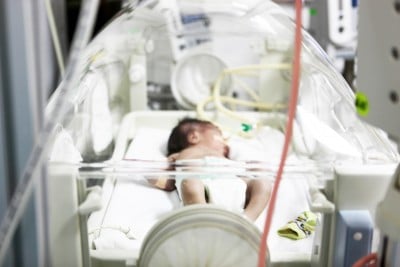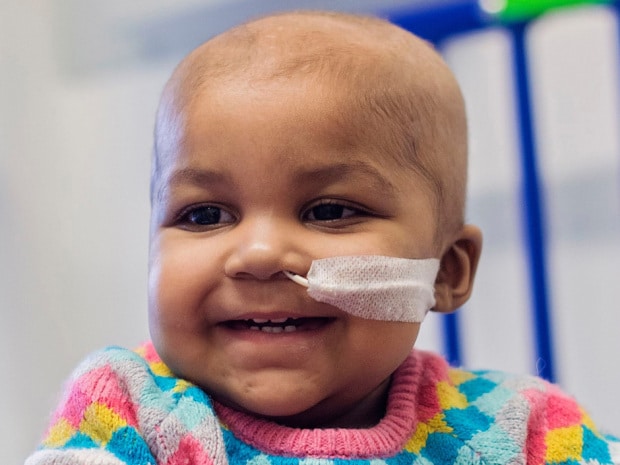Gene therapy involves the use of genetic material to compensate for abnormal genes or to encourage the production of beneficial proteins. Though experts have long suspected that it could hold the key to curing certain genetic conditions, recently, its sordid history made it an area of science that most avoided. Thankfully, a few brave and intelligent souls kept working on the controversial treatment – and it appears that one has not only managed to prove that gene therapy can be used safely, but that it also does have the potential to save lives.
Evelyn Villarreal is just one of the 15 babies treated in the clinical trial. She is also a miracle, a welcome surprise, a beautiful blessing, and the second child of Elena and Milan Villarreal. Their first, Josephine, had spinal muscular atrophy type 1 (SMA1), a genetic condition that gradually paralyzes babies. She died at just 15 months.
Evelyn, though not planned for, came along a short time after the loss of their first child. Milan and Elena decided to go through with the pregnancy, even though they knew there was a one-in-four chance that she, too, would be born with the condition. Tests confirmed their worst fears shortly after Evelyn’s birth. It appeared that the Villarreal family would face yet another tragedy – or they would have, had it not been for the clinical trial.
“It opens up a whole new concept to a field that has been very cautious,” Federico Mingozzi, who recently left the French nonprofit Généthon to become a chief scientific officer of the gene therapy company Spark Therapeutics in Philadelphia, Pennsylvania, told Science Magazine.
“People are going to look back and see this as a milestone in a new type of medicine that’s going to have broad implications for lots and lots of diseases,” genetic researcher, Steven Gray of the University of North Carolina (UNC) in Chapel Hill, told Science Magazine.
These statements, though bold, are backed by evidence – a happy and bubbly almost 3-year-old, twirling to music in a pair of tights. She is the miracle that the Villerreals never expected.
Given a gene therapy injection at just 8 weeks old, Evelyn’s body appears to be making the crucial missing protein that is lacking in children with SMA1 – and she isn’t the only one. Every one of the infants, all expected to die before the age of 2, is still alive at the age of 20 months.
At least one other child, a boy who received the injection just days after his birth, is just as active as Evelyn. Only eight of the toddlers now need face masks to help them breathe, and 11 of the 12 who received high doses of the gene therapy injection can eat, speak, and briefly sit up without assistance. One of those children received the injection quite late – at 6 months old, which is far past the “optimal” stage. In fact, the earlier the treatment, the better.
Once neurons are gone, they’re gone,” pediatric neurologist Jonathan Mink of the University of Rochester Medical Center in New York told Science Magazine.
What does all this mean for parents dealing with other serious genetic conditions? How far does science plan to go, and what can we expect to see next?
For now, not much. Gene therapy still has a lot to prove – especially in terms of efficacy and safety. However, those that have had a child with a genetic condition may soon start to hear from places doing clinical trials. We have at least determined that it can be done safely, and with some benefit, and scientists hope to start using it on other serious childhood conditions. For example, there is one ongoing study in which researchers are using an IV delivery of a similar gene to see if it will help with Sanfilippo type A syndrome, a condition in which children are missing an important enzyme that is needed to break down heparin sulfate, a molecule that builds up in the brain and can ultimately cause death. It has been widely successful thus far, much like the SMA1 trial, but official results have yet to be released. There are also other studies using other means of delivery and spinal injections. But they are all working toward the same goal – to bring science to a whole new level and hopefully make at least some genetic condition deaths a thing of the past.
For example, there is one ongoing study in which researchers are using an IV delivery of a similar gene to see if it will help with Sanfilippo type A syndrome, a condition in which children are missing an important enzyme that is needed to break down heparin sulfate, a molecule that builds up in the brain and can ultimately cause death. It has been widely successful thus far, much like the SMA1 trial, but official results have yet to be released. There are also other studies using other means of delivery and spinal injections. But they are all working toward the same goal – to bring science to a whole new level and hopefully make at least some genetic condition deaths a thing of the past.
There are also other studies using other means of delivery and spinal injections. But they are all working toward the same goal – to bring science to a whole new level and hopefully make at least some genetic condition deaths a thing of the past.







